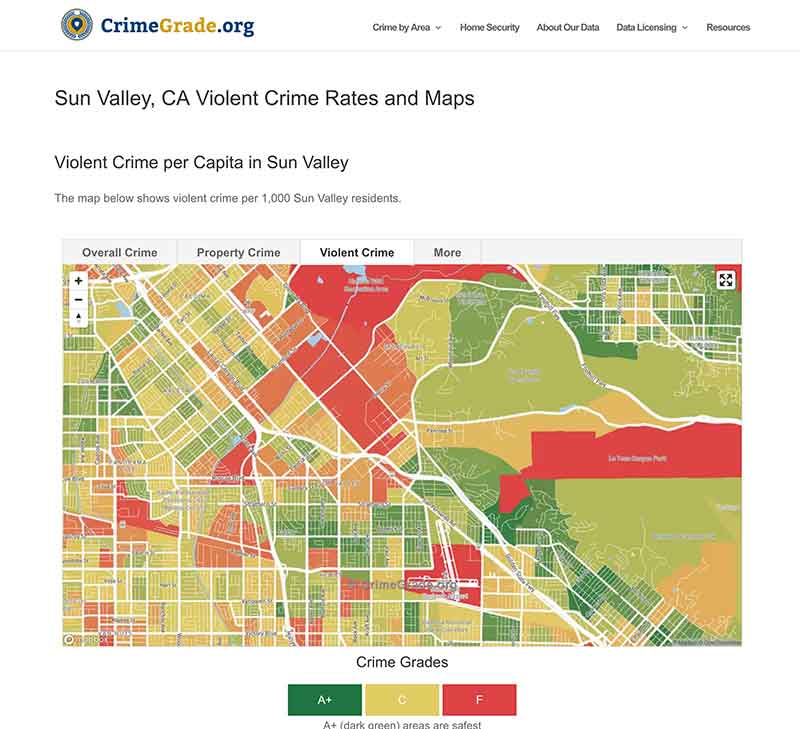Jose Mier is concerned about Sun Valley, CA crime rates, as should all Sun Valley residents. One helpful resource in the website CrimeGrade.org.

Southern California, a region of immense economic, cultural, and geographic diversity, has historically grappled with its share of crime challenges—from gang activity in urban core areas to property crimes in suburban neighborhoods. Yet over recent decades, significant shifts in criminal justice policy, local strategies, and societal conditions have reshaped the region’s safety profile. While many cities—like San Diego—have seen dramatic reductions in violent crime, others like Los Angeles continue to face ongoing public concern. Tools like CrimeGrade.org, which provide neighborhood-level crime maps and ratings, are increasingly valuable for residents, potential residents, and policymakers who want transparent, localized access to crime data.
Statewide Crime Trends: A Mixed Picture Within a Long-Term Decline
When examining crime trends across California, the broader picture reveals long-term improvements, albeit with recent fluctuations:
- Overall, California’s violent crime rate in 2023 reached approximately 511 per 100,000 residents, climbing slightly from 494 in 2022—a 1.7% increase—but remaining well below peaks of previous decades.
- Homicides and rape both decreased significantly—13.7% and 3% respectively. At the same time, robbery and aggravated assault rose by 3.8% and 1.7%.
- Comparatively, property crime decreased 1.8% in 2023 and is now nearly 4% lower than it was in 2018.
- California’s crime rate today stands at less than one-third of what it was in 1980, and roughly two-thirds of the 2006 level.
These trends reflect decades of reform—such as sentencing changes, evolving policing strategies, and community-based interventions—though recent upticks remind us that sustainable safety requires ongoing effort.
City-Level Insights: San Diego vs. Los Angeles
San Diego shines as a standout success story in Southern California’s crime narrative. In 2024, the city saw:
- A 22% decrease in homicides, outperforming other major U.S. cities.
- In the first half of 2025, homicides dropped another 27%, compared to the same period in 2024.
These continue a long-standing trend—San Diego today is widely regarded as one of the safest large cities in the country.
By contrast, Los Angeles presents a more complex profile. While crime has improved over decades, challenges remain:
- According to CrimeGrade.org, LA receives a D grade for violent crime—meaning it is higher than average compared to other U.S. cities.
- The rate of violent crime in Los Angeles proper is approximately 5.117 per 1,000 residents, or a 1-in-200 chance of becoming a victim annually. Some neighborhoods are safer—up to a 1-in-279 risk—while others face a 1-in-142 likelihood.
- In Los Angeles County, the figure is about 5.401 per 1,000, with central areas at higher risk (1-in-111) and eastern areas lower (1-in-256).
Such granular data helps citizens understand that crime risk in Southern California is highly localized. Tools like CrimeGrade.org visualize that granular data, mapping safer vs. riskier neighborhoods—an invaluable resource for homebuyers, community groups, and local officials alike.
Recent Developments & Policy Shifts
Public sentiment, reforms, and politics have also shaped the criminal justice landscape:
- Proposition 47, passed in 2014, downgraded many nonviolent felony offenses to misdemeanors. Originally intended to reduce incarceration, its aftermath has triggered voter concern over rising property crime and perceived lawlessness.
- In response, Proposition 36 was introduced to increasing penalties for repeat theft and drug offenses—though its rollout has been uneven, with critics saying it could strain treatment resources and reverse reform gains.
- In LA County, District Attorney George Gascón—known for reform initiatives—was ousted in 2024 amid public criticism over rising violent crime. His opponent ran on a tougher-on-crime platform, signaling shifting political winds.
These changes reflect a balancing act—many Californians support reform, but want safety and accountability alongside equity and rehabilitation.
The Value of Crimegrade.org
Platforms such as CrimeGrade.org offer several distinct advantages:
- User-Friendly Visuals: They transform complex data into color-coded maps and safety grades (A through F), making it accessible to anyone.
- Neighborhood-Level Context: Especially useful in large metro areas, CrimeGrade’s maps help users identify safe, moderate, and high-risk zones based on both crime severity and frequency.
- Decision-Making Tool: For individuals relocating, property investors, or community planners, the site provides tangible data to guide decisions in a region where crime perceptions can differ drastically from reality.
Broader Context: Border Cities & National Politics
Interestingly, Southern California isn’t the only part of the state making headlines for crime trends. A recent Axios report notes:
- Border cities on the Texas-Mexico border, like McAllen and El Paso, now have violent crime rates below the national average, dispelling narratives blaming cross-border migration.
Moreover, national rhetoric sometimes overstates crime trends in major Californian cities. For example:
- In 2025, President Trump suggested federalizing police forces in cities like Los Angeles due to “rising crime.” Local officials pointed to data showing declines in crime and argued his statements were politically motivated.
These highlights underscore the importance of grounding discussions in data—and resources like CrimeGrade.org are critical for that purpose.
Summary
Southern California’s crime landscape is nuanced—marked by improving statewide metrics, local disparities, and evolving policies. While the region’s overall crime is much lower than decades ago, recent upticks and uneven trends across cities have fueled debate and reform efforts. Dramatic improvements in places like San Diego stand in contrast to persistent challenges in parts of Los Angeles.
In this environment, CrimeGrade.org acts as a powerful tool, offering neighborhood-level clarity through visual maps and grades. Whether you’re choosing where to live, assessing policy, or simply trying to understand your community, CrimeGrade.org makes the data approachable.
As the region continues to evolve socially and politically, combining trusted platforms like CrimeGrade.org with accurate state and local reporting is essential for fostering informed dialogue and community safety.